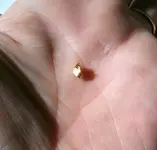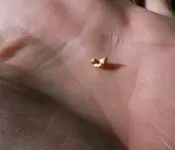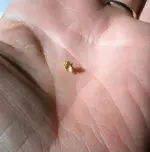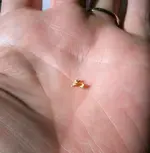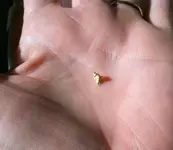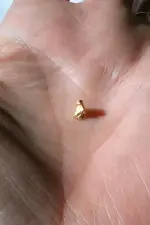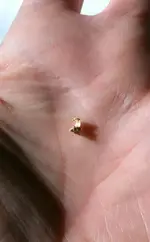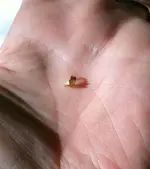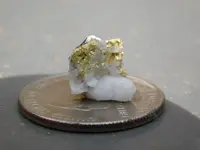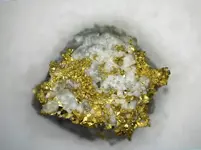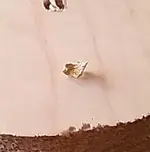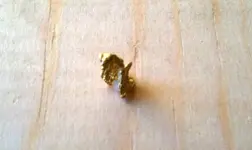You are using an out of date browser. It may not display this or other websites correctly.
You should upgrade or use an alternative browser.
You should upgrade or use an alternative browser.
How would you classify this little gold nugget?
- Thread starter deserdog
- Start date
- Joined
- Nov 14, 2010
- Messages
- 4,958
- Reaction score
- 14,522
- Golden Thread
- 0
- Location
- The Great Southwest
- Primary Interest:
- Prospecting
Nice find deserdog. That came from very near the source. 
Most striations on gold nuggets are caused by the minerals around them when the gold was deposited out of solution. Your nugget looks like an epimorph created by the gold depositing on another mineral and then the other mineral is dissolved or weathered away. Epimorphs are very common with raw gold found near the source because gold is an element and weathers slower than virtually every other mineral it's found in association with.
Less commonly gold is found as a pseudomorph by replacement into a cavity formed by another mineral that dissolved before the gold was deposited.
Pseudomorphs and epimorphs are not rare in raw gold. It's very rare to find crystallized gold but it does exist. Here are some examples of the forms gold crystallizes in:
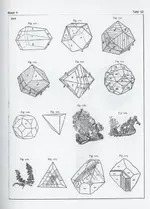
And here are some pictures of crystallized gold in several forms. You will notice that most crystallized gold forms cubes or stacked pyramids. That's because gold is in the isometric crystal system. (There are several interactive 3D crystal forms you can investigate when you scroll down on that page)
Here is some good basic information on mineral replacement.
Heavy Pans

Most striations on gold nuggets are caused by the minerals around them when the gold was deposited out of solution. Your nugget looks like an epimorph created by the gold depositing on another mineral and then the other mineral is dissolved or weathered away. Epimorphs are very common with raw gold found near the source because gold is an element and weathers slower than virtually every other mineral it's found in association with.
Less commonly gold is found as a pseudomorph by replacement into a cavity formed by another mineral that dissolved before the gold was deposited.
Pseudomorphs and epimorphs are not rare in raw gold. It's very rare to find crystallized gold but it does exist. Here are some examples of the forms gold crystallizes in:

And here are some pictures of crystallized gold in several forms. You will notice that most crystallized gold forms cubes or stacked pyramids. That's because gold is in the isometric crystal system. (There are several interactive 3D crystal forms you can investigate when you scroll down on that page)
Here is some good basic information on mineral replacement.
Heavy Pans
Last edited:
Laz7777
Sr. Member
- Joined
- Dec 19, 2015
- Messages
- 255
- Reaction score
- 494
- Golden Thread
- 0
- Location
- South Fork Yuba River, Motherlode
- Detector(s) used
- GoldBug II
- Primary Interest:
- Prospecting
if you think it's a nug, then it's a nug.
not sure if that was what you were looking for.
it's like the definition of "picker"...everyone has their own.
biggest I've ever found was 11 grain, which is roughly 0.7 gram. still I wouldn't call that a nug, but that's me.
BTW, a picker for me is anything I don't have to struggle to pick out of a pan..if I can grab it with thumb and forefinger without a fuss, it's a picker.
still, your "piece" is purdy, must not have travelled very far from the source.
not sure if that was what you were looking for.
it's like the definition of "picker"...everyone has their own.
biggest I've ever found was 11 grain, which is roughly 0.7 gram. still I wouldn't call that a nug, but that's me.
BTW, a picker for me is anything I don't have to struggle to pick out of a pan..if I can grab it with thumb and forefinger without a fuss, it's a picker.
still, your "piece" is purdy, must not have travelled very far from the source.
goldenIrishman
Silver Member
- Joined
- Feb 28, 2013
- Messages
- 3,465
- Reaction score
- 6,154
- Golden Thread
- 0
- Location
- Golden Valley Arid-Zona
- Detector(s) used
- Fisher / Gold Bug AND the MK-VII eyeballs
- Primary Interest:
- Other
The "official" stages of gold size as defined by G.I......
Stage 1. Dust = requires a good lens to see and usually saved for the amalgam run.
Stage 2 Suckable gold = Gold so small you have to use a sucker bottle to get it out of the pan.
Stage 3 Tweezeable gold = Easier to see and can be grabbed with tweezers. (lower stage of pickers)
Stage 4 Finger Picker = Nuggets you can pick from your pan or sluice with your fingers (upper stage of pickers)
Stage 5 Fisters = nuggets that you can grab out of the sluice and have almost cover the palm of your hand. Also found in the tailing pile of people that don't pay attention while classifying their materials.
Stage 6 OMG = Nuggets you need either 3 men and a small boy to pick up or a small construction crane (rarest stage of pickers)
Stage 1. Dust = requires a good lens to see and usually saved for the amalgam run.
Stage 2 Suckable gold = Gold so small you have to use a sucker bottle to get it out of the pan.
Stage 3 Tweezeable gold = Easier to see and can be grabbed with tweezers. (lower stage of pickers)
Stage 4 Finger Picker = Nuggets you can pick from your pan or sluice with your fingers (upper stage of pickers)
Stage 5 Fisters = nuggets that you can grab out of the sluice and have almost cover the palm of your hand. Also found in the tailing pile of people that don't pay attention while classifying their materials.
Stage 6 OMG = Nuggets you need either 3 men and a small boy to pick up or a small construction crane (rarest stage of pickers)
Last edited:
johnedoe
Bronze Member
- Joined
- Jan 15, 2012
- Messages
- 1,489
- Reaction score
- 2,242
- Golden Thread
- 0
- Location
- Oregon Coast
- Detector(s) used
- White's V3i, White's MXT, and White's Eagle Spectrum
Cleangold sluice & prospectors pan, EZ-Gold Pan, and custom cleanup sluice.
- Primary Interest:
- Other
I'd call it a pickernug, definitely a picker but not quite a nugget..... But hey, what do I know... I'm a beach miner..

Bodfish Mike
Hero Member
- Joined
- Dec 12, 2014
- Messages
- 513
- Reaction score
- 1,403
- Golden Thread
- 0
- Location
- Bodfish and Marin county CA
- Detector(s) used
- Garrett , Whites
keene puffer drywasher , Keene A51 Sluice
- Primary Interest:
- Other
I would classify it as awesome.
A clicker (makes a click when sucked up the snuffer bottle) though it may not fit up the snuffer tube.
Nice Nug.
Mike
A clicker (makes a click when sucked up the snuffer bottle) though it may not fit up the snuffer tube.
Nice Nug.
Mike
bug
Full Member
The striations may be the crystal growth lines, also.
"Crystals that develop under conditions of rapid growth and high degrees of supersaturation so that atoms or ions are added more rapidly to edges and corners of growing crystals, resulting in branched 'dendrites' or hollow stepped depressions, 'hoppers'. Ice on windowpanes (frost) and pyrolusite on agate (moss agate) are dendrites, halite and gold may form hopper crystals."
"Crystals that develop under conditions of rapid growth and high degrees of supersaturation so that atoms or ions are added more rapidly to edges and corners of growing crystals, resulting in branched 'dendrites' or hollow stepped depressions, 'hoppers'. Ice on windowpanes (frost) and pyrolusite on agate (moss agate) are dendrites, halite and gold may form hopper crystals."
Attachments
425jesse
Hero Member
- Joined
- Feb 10, 2013
- Messages
- 588
- Reaction score
- 819
- Golden Thread
- 0
- Location
- Mountlake Terrace
- Detector(s) used
- 4" Dalke Original Compact Dredge, 36" BGT Prospector, 30" BGT Sniper, D&D/Brawn Super Concentrator and Highbanker top, Brawn/D&D finishing table, pans and more!
- Primary Interest:
- Prospecting
Nug for sure, when dropped in the pan, it would make a noise....NUGGET ALERT!!!

- Joined
- Jan 1, 2013
- Messages
- 2,664
- Reaction score
- 5,462
- Golden Thread
- 0
- Detector(s) used
- Tesoro Vaquero, Whites MXT, Vsat, GMT, 5900Di Pro, Minelab GPX 5000, GPXtreme, 2200SD, Excalibur 1000!
- Primary Interest:
- All Treasure Hunting
You said, "You can still see the striations on the gold from when it came out of solution in an open cavity", so I presume it would simply be called lode gold if you burned the rock from around it. Throw it in with the rest of the pile because lode gold sells for spot unless it's something special. What type of solution?
Kenmitch
Sr. Member
- Joined
- Jan 1, 2013
- Messages
- 2,664
- Reaction score
- 5,462
- Golden Thread
- 0
- Detector(s) used
- Tesoro Vaquero, Whites MXT, Vsat, GMT, 5900Di Pro, Minelab GPX 5000, GPXtreme, 2200SD, Excalibur 1000!
- Primary Interest:
- All Treasure Hunting
A $7 picker, would be another way 

Laz7777
Sr. Member
- Joined
- Dec 19, 2015
- Messages
- 255
- Reaction score
- 494
- Golden Thread
- 0
- Location
- South Fork Yuba River, Motherlode
- Detector(s) used
- GoldBug II
- Primary Interest:
- Prospecting
can see some quartz now and looks a lot less smooth than it did in the earlier photos.
was this from a streambed or as your name implies, somewhere in the desert?
color is nice as well, doesn't look so brassy or green, which indicates a high silver content, but pctures especially digital ones are poor.
also, the quality of my monitor can effect a pic.
was this from a streambed or as your name implies, somewhere in the desert?
color is nice as well, doesn't look so brassy or green, which indicates a high silver content, but pctures especially digital ones are poor.
also, the quality of my monitor can effect a pic.
deserdog
Hero Member
- Joined
- May 17, 2013
- Messages
- 508
- Reaction score
- 444
- Golden Thread
- 0
- Primary Interest:
- All Treasure Hunting
- #17
Thread Owner
I need a good camera. If I am remembering correctly, it was from the desert side of the San Bernardinos. And from material on the side of the mountain, when I was running samples. Never did find another piece though. Found another piece of very rough wire gold, when I was sampling another area once. It was not in the stream either.
GoldpannerDave
Bronze Member
- Joined
- Apr 17, 2014
- Messages
- 1,076
- Reaction score
- 1,279
- Golden Thread
- 0
- Location
- Colorado Springs, CO
- Detector(s) used
- Bazooka 48" Miner and 30" Sniper, Le Trap, Wolf Trap, A52, 2" dredge, Miller tables, Blue Bowl, wheel, Falcon MD20, old White's detector
- Primary Interest:
- Prospecting
One of my problems is that I do not have a good camera with marcro capability, so the picturres I took do not do it justice.
See if either of these pics are better.
View attachment 1394547View attachment 1394548
Looks like a bit of quartz with it in the last picture. Merry Christmas.
Similar threads
- Replies
- 27
- Views
- 3K
Users who are viewing this thread
Total: 1 (members: 0, guests: 1)

